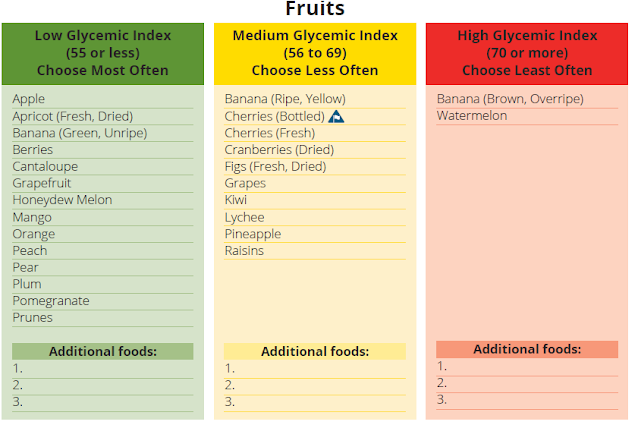Glycemic Index Food Guide
Glycemic Index Food Guide
The glycemic index (GI) is a scale that ranks a
carbohydrate-containing food or drink by how much
it raises blood sugar levels after it is eaten or drank.
Foods with a high GI increase blood sugar higher
and faster than foods with a low GI.
There are three GI categories
Green = Go
Low GI (55 or less) Choose Most Often
Yellow = Caution
Medium GI (56 to 69) Choose Less Often
Red = Stop and think
High GI (70 or more) Choose Least Often
Foods in the high GI category can be swapped
with foods in the medium and/or low GI category
to lower GI.
A low GI diet may help you:
• decrease risk of type 2 diabetes and
its complications
• decrease risk of heart disease and stroke
• feel full longer
• maintain or lose weight
Try these meal planning ideas to lower meal GI:
• Cook your pasta al dente (fi rm). Check your
pasta package instructions for cooking time.
• Make fruits and milk part of your meal plate
(Figure 1). These foods often have a low GI and
make a healthy dessert.
• Try lower GI grains, such as barley and bulgur.
• Pulses can be grains and starches or meat and
alternatives. Swap half of your higher GI starch
food serving with beans, lentils or chickpeas. For
example, instead of having 1 cup of cooked short
grain rice, have ½ cup of cooked rice mixed with
½ cup of black beans.
Diabetes Canada recommends choosing
lower GI foods and drinks more often to help
control blood sugar.
Work with your Registered Dietitian to add foods
and drinks to your lists, create action plans that
include choosing lower GI foods, adapt your
favourite recipes, and fi nd ways to swap/substitute
low GI foods into your meal plan.
Checking your blood sugar before, and 2 hours
after, a meal is the best way to know how your body
handles certain foods and drinks
Some carbohydrate-containing foods and drinks
have so little carbohydrate that they do not have
a GI value. This does not mean they cannot be
included as part of a healthy diet. Examples
include green vegetables, lemons, and some lowcarbohydrate
drinks. Diabetes Canada calls these
foods and drinks “free” because they do not impact
the blood sugar of people living with diabetes. You
can put free foods in the green category, but they
do not have a GI and have not been included in the
food lists.
Most starchy/sweet vegetables (e.g. peas, parsnip, winter squash) provide 15 g or more carbohydrate per 1 cup
serving. Beets and carrots often provide less than 15 g carbohydrate per serving (marked above with *). Most
non-starchy (or free) vegetables (e.g. tomato and lettuce) have not been assigned a GI because they have very
little carbohydrate and have very little effect on blood sugar.
.
Milk, alternatives, and other beverages listed include fl avoured (e.g. chocolate), sweetened and
unsweetened varieties.
Diabetes Canada is making the invisible epidemic of diabetes visible and urgent. Eleven million Canadians have diabetes or prediabetes. Now is
the time to End Diabetes - its health impacts, as well as the blame, shame and misinformation associated with it. Diabetes Canada partners with
Canadians to End Diabetes through education and support services, resources for health-care professionals, advocacy to governments, schools
and workplaces, and funding research to improve treatments and fi nd a cure.
This document refl ects the Canadian Diabetes Association 2013 Clinical Practice Guidelines for the Prevention and Management
of Diabetes in Canada © 2013 The Canadian Diabetes Association. The Canadian Diabetes Association is the registered owner of the name Diabetes Canada. 115009 02/18
Meat, poultry and fi sh do not have a GI because they do not contain carbohydrate. When ½ cup or more of pulses
are eaten, they can be included in the Grains and Starches food group or the Meats and Alternatives group







Comments
Post a Comment